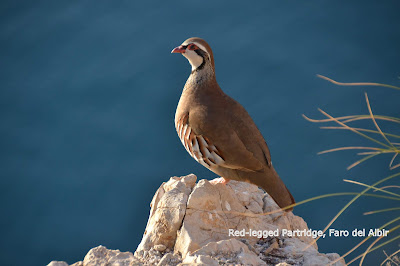Faro-Coto Donana-Tarifa round trip
As Faro is close to Coto Donana, we chose that airport rather than Malaga, which we always use when going to Andalucia. You will use about one hour to the Spanish border, and then you can start birding in the Huelva province straight away.
Our first stop was in El Rocio, the heart of Coto Donana. As I have been there several times before, it was quite easy to compare to previous trips. And the first impression was a rather full lagoon, with little birds. Of course, the usual stuff with flamingoes, White Storks, Glossy Ibises and Spoonbills. Of ducks, I noted Shovelers, Gadwalls and Teals. But, it was few african migrants, meaning no warblers, pratincoles, marsh terns or Bee-eaters and few swallows and swifts. During the trip I spoke with a lot of people and all said the same thing. It is an extraordinary late spring. Some talk about a month late.

Anyway, after a night in El Rocio, we went up to Dehesa de Abajo. This is a really nice area. Perhaps a bit zoo-like, for some people, as the large populations of White Storks and Black kites breed so close and everywhere. But, that is the charm of this site. Further, the lagoon was full with water, and thus promising a good season for water birds. As it was rather windy, most of the water birds gathered on the opposite side, so identification was a bit difficult. We noted Red-crested Pochards rather close.

We then went down to Tarifa and spent three days there. As the whether had been rather poor for several weeks, I was expecting a massive migration over the Strait, since the whether now was improving. But that was not the case. Most probably, the constant north-western winds over a long periode would have halted the migration also well into Africa. Anyway, the raptor migration was going on all days. Staring a bit late, and continuing well into the evening. As the winds were mostly westerly, Punta Carnero was by far the best. Hundreds of Black Kites and Booted Eagles came in there. However also around Tarifa there was visible migration with White Storks, the occasional Black Stork, Booted Eagles, still some Short-toed and some 2-3 Montague's Harriers per days. One day up to 5 Egyptian Vultures also appeared. However, where were the hirundines, swifts and Bee-eaters?
Along Los Lances, I noted the first Northern Wheatear, Yellow Wagtails and Short-toed Larks. Also the usual masses of gulls including Audouins and Caspian Tern.

For the first time we also took a short trip to the rubbish dump at Los Barrios to look at the Black Kites and White Storks. Some say up to 2000 Black Kites have been spotted there at the same time. We had lots, but not that number...
On the detour we went back to Donana and stayed at a four star in Matalascanas. In Laguna Madre, I finally had about 15 Pratincoles, so at least some migrants were on the move. And as always, the Azure-winged Magpies in El Acebuche is worth a visit there.

At the last day, we visited an area I havent seen before, Isla Christina between Huelva and the border. The salt-pans there held the same birds as such areas everywhere; Avocets, Black-winged Stilts, Flamingoes and Slender-billed Gulls. In addition, there were some good flocks of waders, dominated by Dunlins and Common Ringed Plovers.
Some final words: Due to the whether conditions over Europe in March, a lot of rain has fallen in Southern Spain. This is very welcomed. Lagoons and marshes are quite full, and the same goes with the Embalsas. So even though the spring is late, the state of the wetlands of Andalucia gives hope for a good breeding season.
































